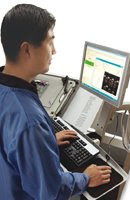IC Test Debug and Troubleshooting in Production Environment
by Allan B. Dizon First, find out what's failing, turn on the datalogger and look closely at the test results. Which test is failing, is it a DC fail, an AC fail or a functional fail? Is only one test failing, one pin failing? These are the common basic questions that need to be answer first before "deep-diving" the problem. Look for basic clues - if problem is not apparent, proceed as follows and remember to solve one problem at a time.
First, find out what's failing, turn on the datalogger and look closely at the test results. Which test is failing, is it a DC fail, an AC fail or a functional fail? Is only one test failing, one pin failing? These are the common basic questions that need to be answer first before "deep-diving" the problem. Look for basic clues - if problem is not apparent, proceed as follows and remember to solve one problem at a time.
- Re-run the loadboard test(usually loadboard calibration or TDR - time domain reflectometry) and hardware diagnostics of the ATE. Continue on fail if the hardware is working. It may also be helpful to remove and reseat the loadboard before re-running the diagnostics.
- Get a known good device (KGD), correlation units or sometimes called golden units and test it. Are the results the same? Has the failing product been successfully tested on this test system before?
- If possible, test the device on a different test system. If the results are the same, it is not a test system problem. If the device passes, contact the test maintenance department and explain the problem seen on the first test system.
- The device will not function correctly if the opens and shorts test is failing. If a number of tests are failing get the opens and shorts test to work first.
A good way to start the investigation is to datalog the test results to a printer or file so that they can be studied. Don't waste expensive tester time viewing results on the video display if you can do it off-line. Datalog all DC and functional pass/fail measurements.
Look carefully at the results of all tests, both passing and failing. There are often helpful clues in the datalog information. Is the device drawing the correctamount of IDD current? Are the leakage tests passing? Are the VOL/VOH voltage correct? If the failures is a DC measurement, see if the failure is just over the limit or if it is a catastrophic failure.
Verify that the test has worked in the past. Are there datalogs showing the results of a successful test? If so, compare the results of all tests.
Make sure that both the test program and the failing device are the correct revisions. If the hardware passes the diagnostics, the standard device fails the same, the parts and the test program are of the correct revision, pick one test and find out why it is failing. Start by getting an oscilloscope and a DVM. Breakpoint or pause on the failing test and verify that VDD and the input levels are correct. Verify that all timings are correct. Be sure to look at every device pin with oscilloscope, look for noise or levels that appear to be incorrect.
Relax the test parameters to make it easier for the device to pass. Relax VIL/VIH/VOL/VOH and test the device again. Relax the timing parameters (use the scale factor). Test the device again and see if the results change.
It is good idea to limit the number of hours spent debugging one problem. It is an individual choice, but a good rule of thumb is do not spend more than two or three hours working on the test system on a single problem. If you work more that several hourson a single problem, stop take a break, and discuss the issue with your mentor or colleague.
Each ATE systems offer a couple of debugging tools for engineers. Most test systems have some method of looping on a functional test vector pattern and providing a means of creating a sync marker at a selected vector memory location. The test pattern can be started and stopped at any point within the vector set and failures can be ignored. The oscilloscope can be used to verfy the proper timing and voltage levels when verifying a new test program or for investigating test problems. It is absolutely essential to become proficient at using this debug technique.
Shmoo plots are useful fo debugging test holes and for finding the pass/fail limits of device operation. It can be executed from the tester keyboard or from within the test program. This tool is very useful in developing device characterization programs and collecting data for both DC and functional tests.
Search tool performs either a binary or linear search for both DC and functional tests. This tool provides a means to take a quick look at input and output thresholds, or it can be used to provide accurate measurements of device timings. It is also very useful in developing device characterization programs.
Tester resource settings can be read and modified directly from the workstation keyboard. Power supplies, input references, comparator values, timings and functional data can all be manipulated. To debug a test problem, make a breakpoint on the failing test and modify the appropriate parameters. The execute button can be use to verify the results of the modification. An oscilloscope can be used to verify pass/fail results. Become familiar with all of the tester tools - the way will greatly enhance your ability to debug and resolve problems quickly.

Post a Comment